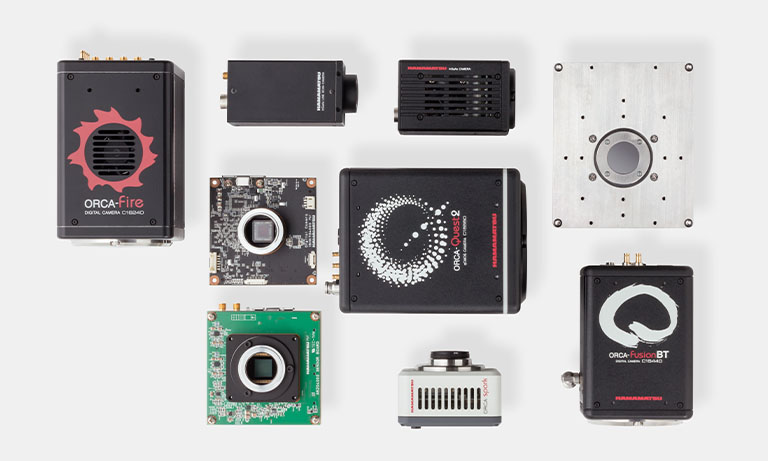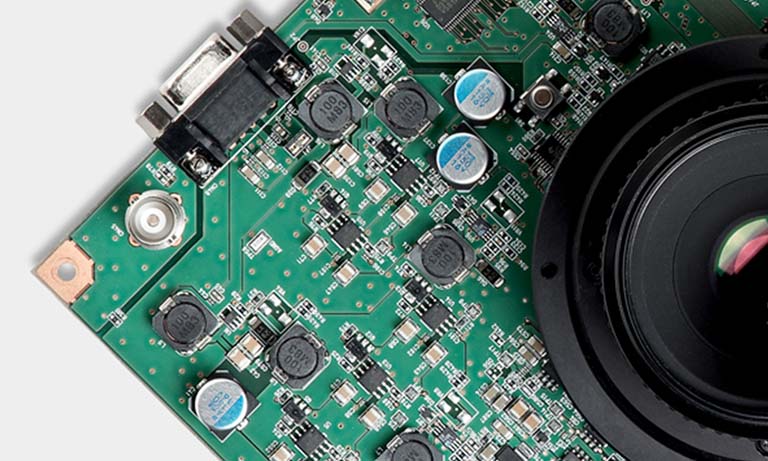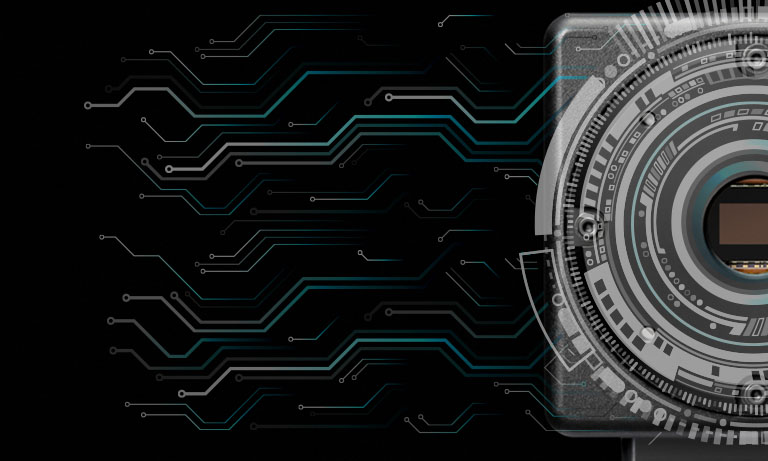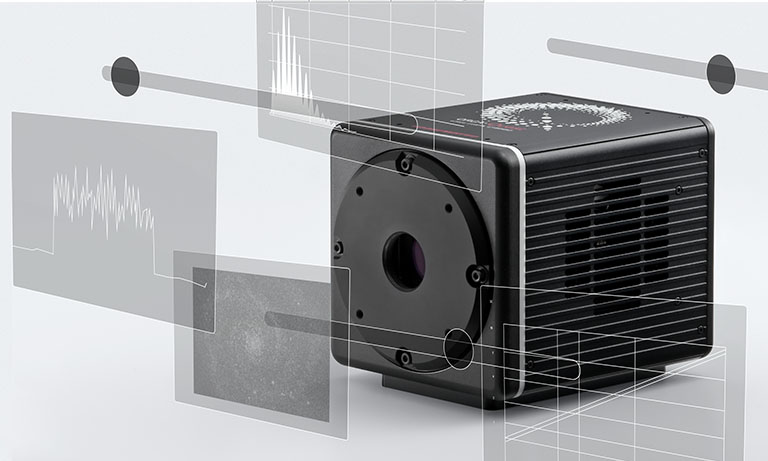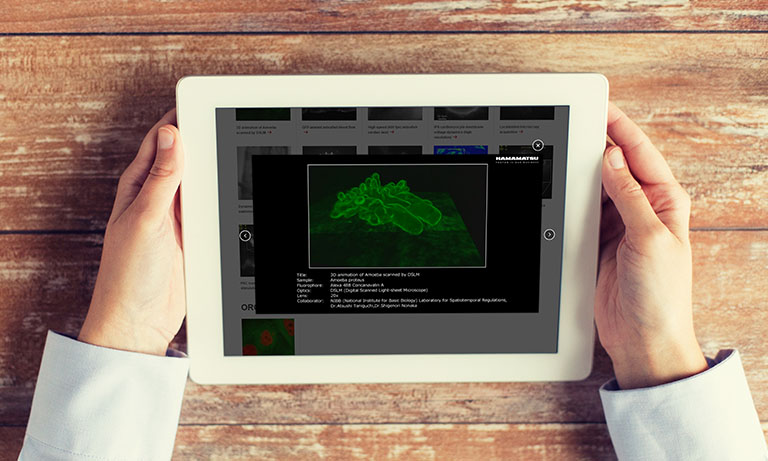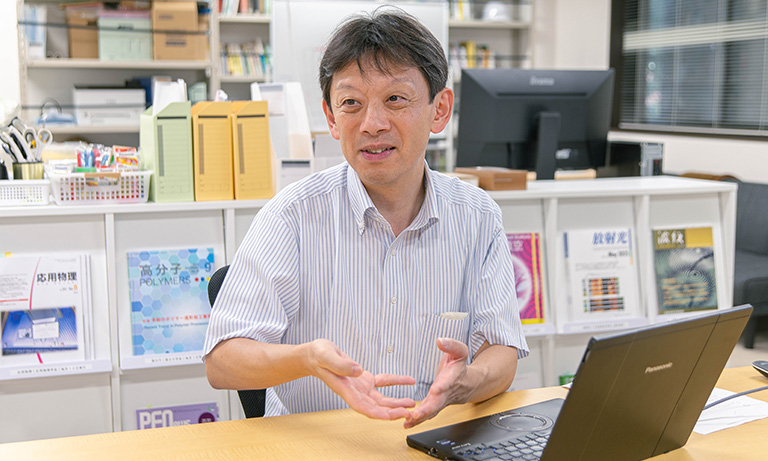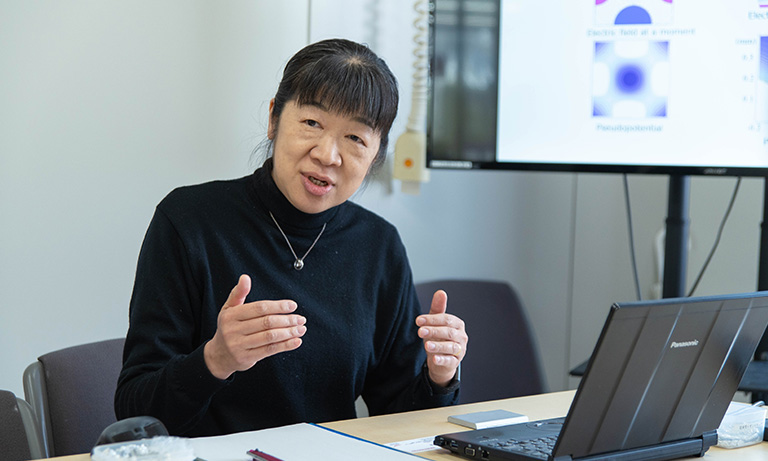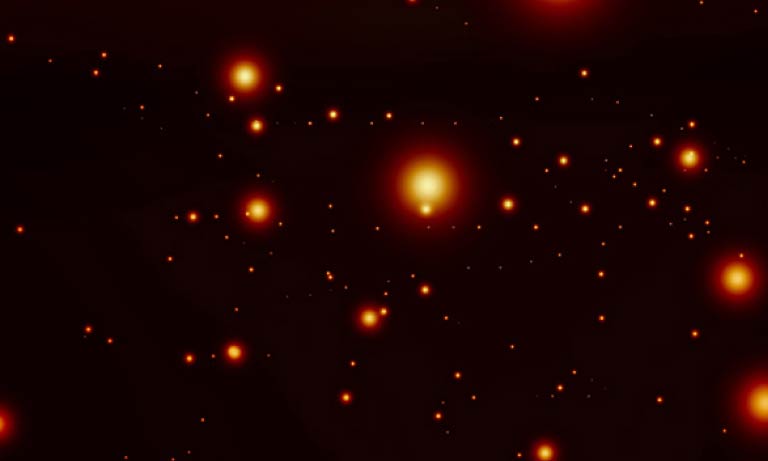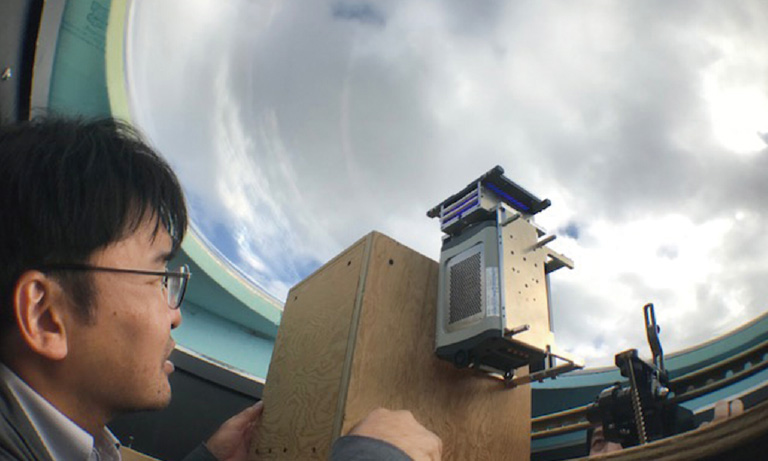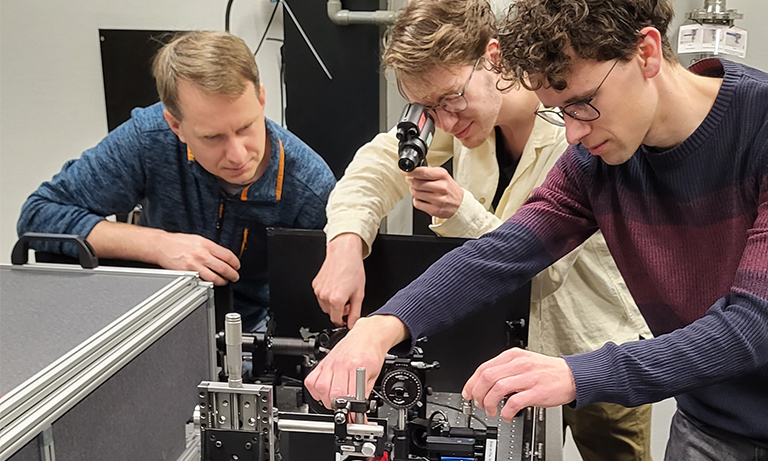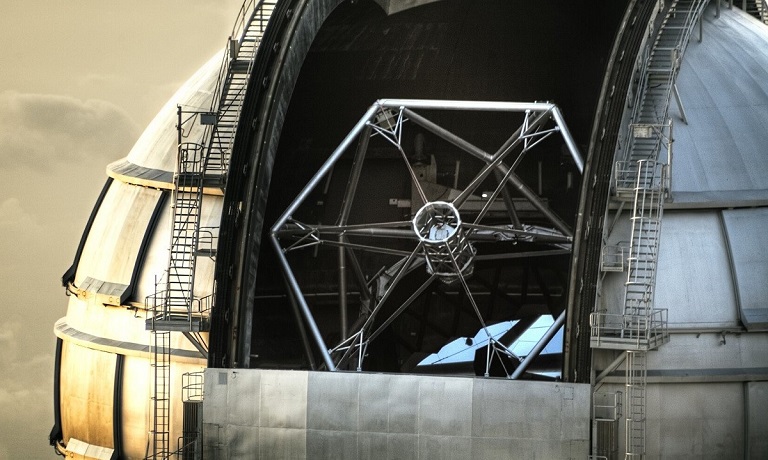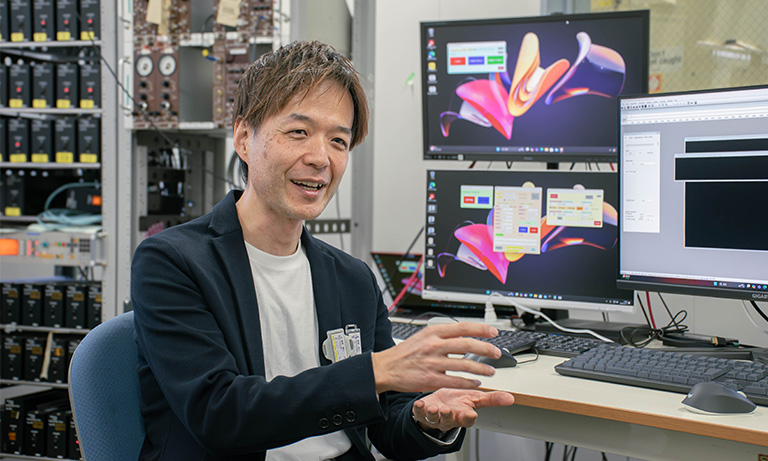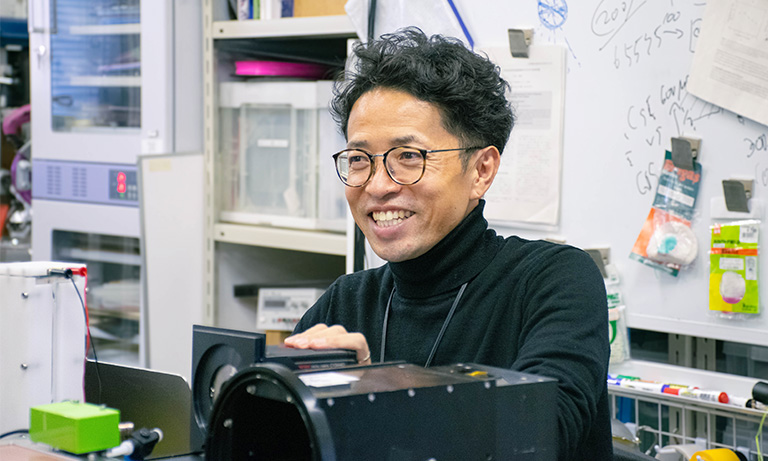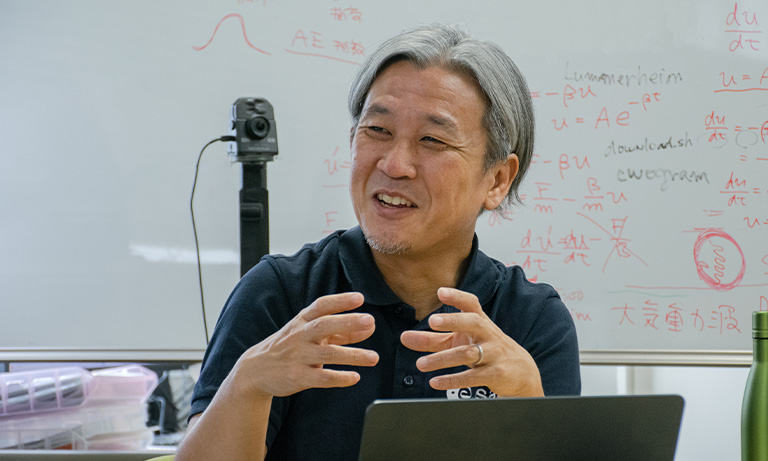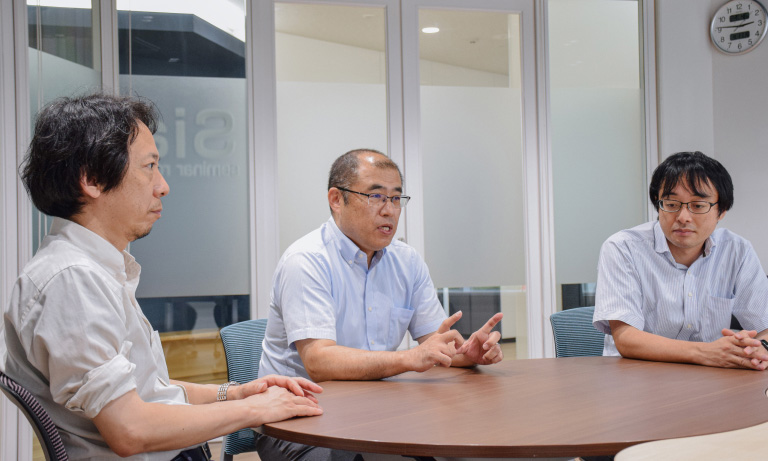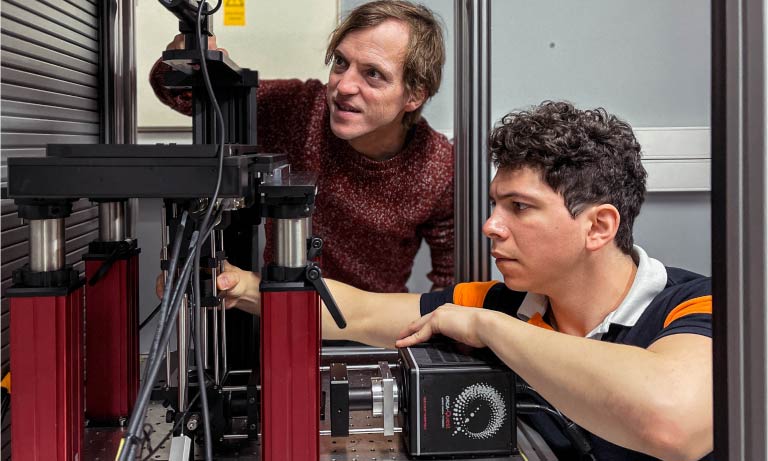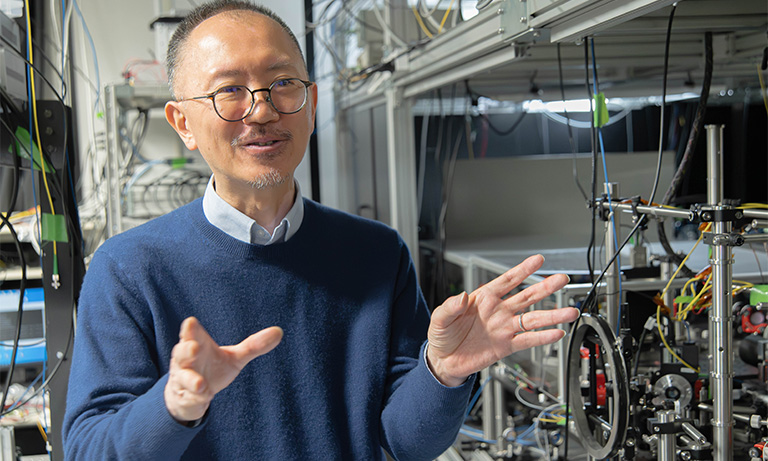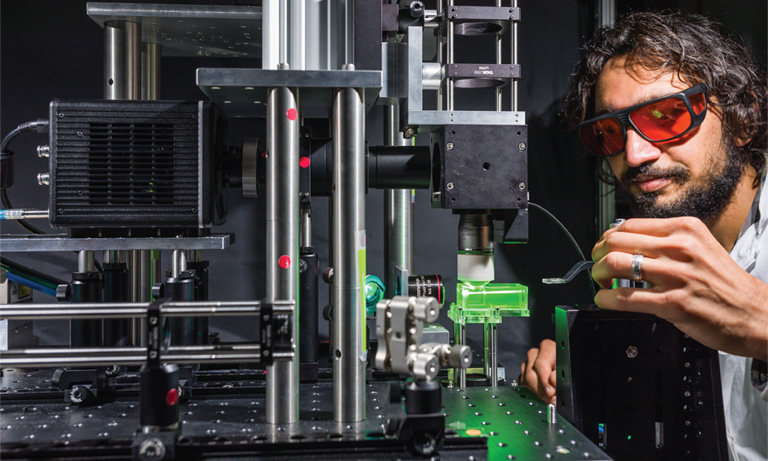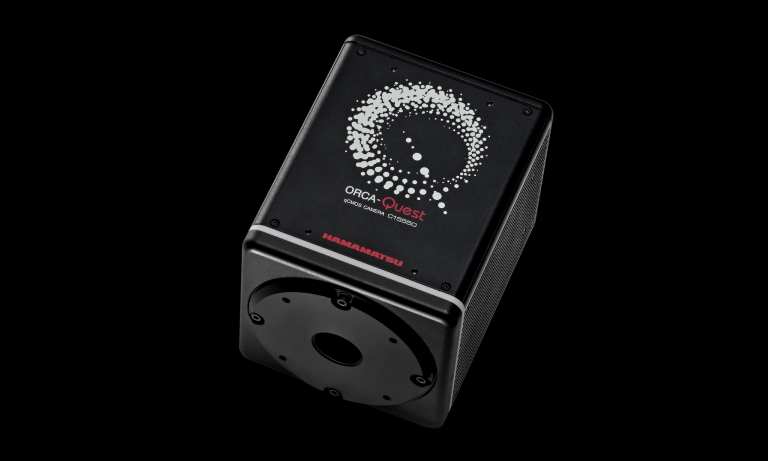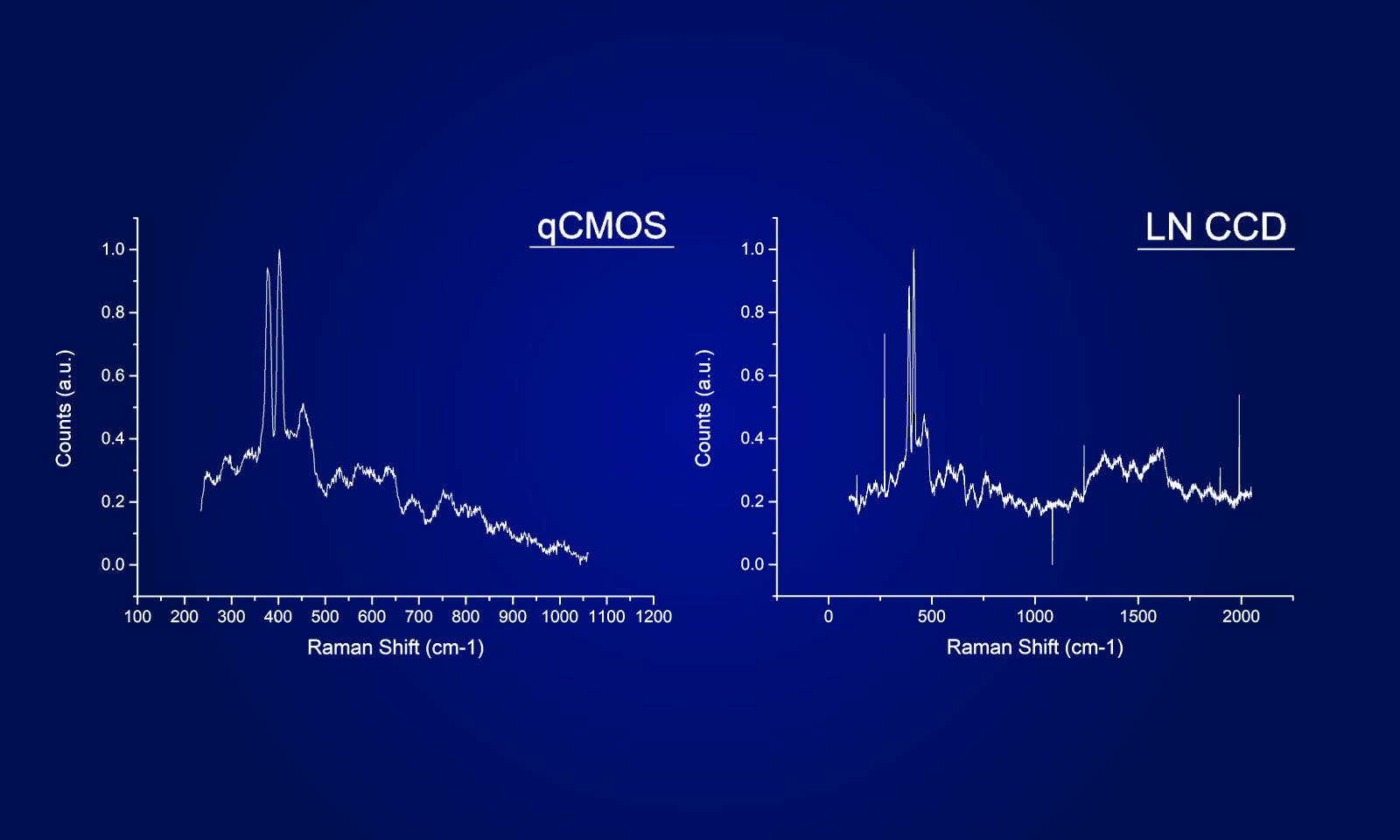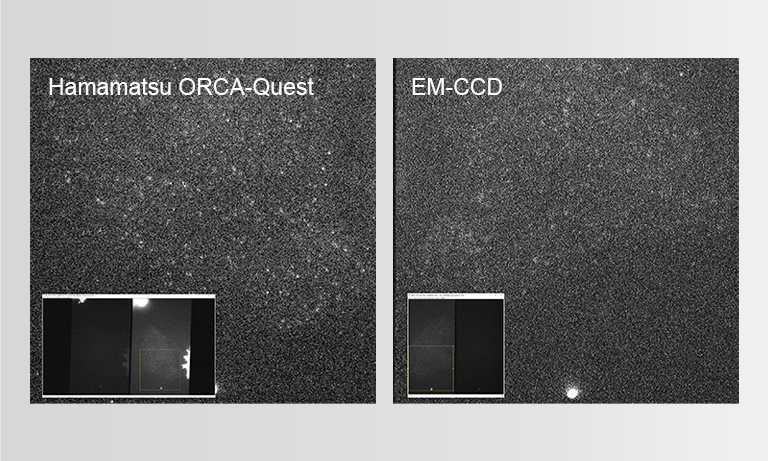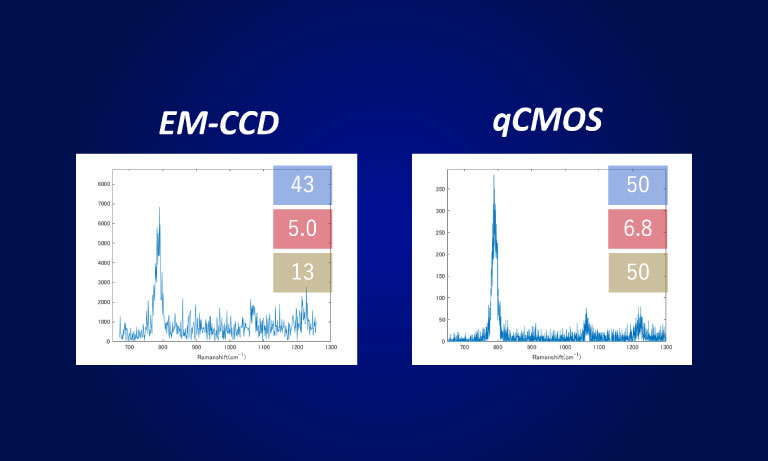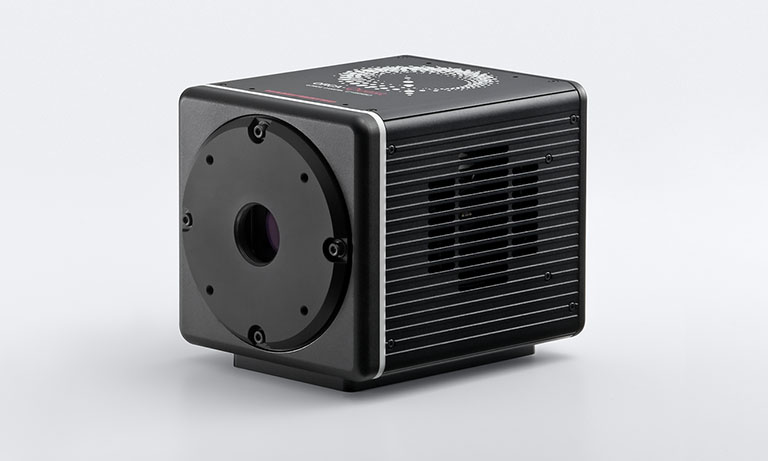Japan (EN)
Select your region or country.
Aurora observation with ORCA®-Quest
Published on February 18, 2025
The Hosokawa Laboratory from the Department of Communication Engineering and Informatics at The University of Electro-Communications uses a high-sensitivity camera to observe auroras. Observation of auroras requires a high frame rate to capture morphology and dynamics, high sensitivity to detect dark auroras, low noise for smooth analysis of acquired images, and large sensor size for wide-field imaging. The ORCA-Quest qCMOSⓇ camera solves these problems.
We interviewed Prof. Keisuke Hosokawa about the reasons for introducing ORCA-Quest, his impressions of using it, and his prospects for future research.
About the research
Could you tell us about your research?
Our laboratory is imaging auroras using high-sensitivity cameras at multiple locations in Northern Europe and Alaska to observe the pulsating aurora, which pulsates with a period of a few to several tens of seconds.
The Pulsating Aurora Project started in 2015. We use a Hamamatsu Photonics EM-CCD camera (ImagEMⓇ) for high-speed, high-sensitivity imaging. We combine ground-based aurora imaging using this camera with observations from the European Incoherent Scatter (EISCAT) radar, the Arase (ERG) satellite. launched in December 2016, and the Pulsating Aurora rocket experiment (LANP mission) launched in 2022. Through this combined approach, we aim to elucidate the origin of pulsating aurora.

Skibotn Observatory, Norway
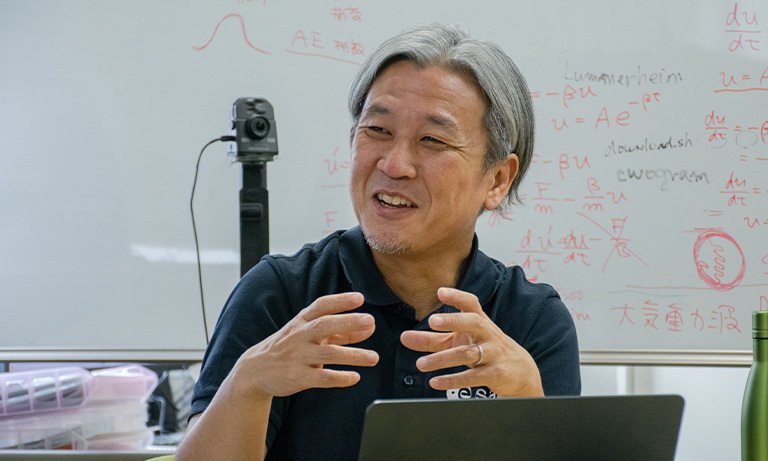
Prof. Keisuke Hosokawa
Problems in aurora imaging
What problems do you face when imaging auroras?
The main problems with aurora imaging are
- Sensitivity to detect dark aurora
- Spatial resolution for detailed observation of auroral morphology
- Camera noise negatively affects data analysis
First, regarding camera sensitivity, previously I used an EM-CCD camera (ImagEM) manufactured by Hamamatsu Photonics. The EM-CCD camera can capture images with extremely high sensitivity by multiplying the incident electrons, making it ideal for high-temporal-resolution aurora observations. However, the large pixel size and low pixel count of EM-CCD cameras limited the spatial resolution for wide-field observations, making it difficult to observe auroral morphology in detail.
As mentioned earlier, the spatial resolution of EM-CCD cameras was a limiting factor. Therefore, we were seeking a camera that could provide higher spatial resolution while maintaining sensitivity. When Hamamatsu Photonics introduced the high-sensitivity and high-resolution ORCA-Quest qCMOS camera, we were excited about the possibility of improving the spatial resolution of our imaging system.
Regarding camera noise adversely affecting data analysis, we need to use a camera with as little noise as possible, because any signals other than the aurora in the captured image will negatively affect the subsequent data analysis. EM-CCD cameras can improve the S/N by multiplying the signal. However, multiplying the signal adds a large noise called excess noise, which causes fluctuations in the background of the acquired image and makes image analysis difficult.

ORCA-Quest inside the dome of the Skibotn Observatory, Norway
Deciding factors for introducing ORCA-Quest

What were the deciding factors for choosing ORCA-Quest?
The most decisive factor in our decision to use ORCA-Quest was its extremely high resolution. While the EM-CCD camera has 512 × 512 pixels, ORCA-Quest has 4096 × 2304 pixels, which is much larger. In addition, each pixel is 4.6 μm × 4.6 μm, whereas the EM-CCD camera is 16 μm × 16 μm, so the ORCA-Quest can observe the aurora with a much higher spatial resolution than the EM-CCD camera. Although the imaging range has changed slightly, the spatial resolution is about 10 times better in images taken with the ORCA-Quest compared to the EM-CCD camera.
Regarding sensitivity, ORCA-Quest is slightly less sensitive than an EM-CCD camera with a large pixel size and an electron multiplication function, but it can detect even quite dark phenomena because the readout noise is very low. EM-CCD cameras can increase the signal by electron multiplication, but the excess noise had a bad effect on the analysis. On the other hand, ORCA-Quest does not generate excess noise because it does not use electron multiplication. In addition, readout noise and dark current noise are very low, so data analysis can be performed without being affected by noise, which is also attractive.
Observation examples
Curtain-shaped aurora
Scan mode: Ultra-quiet scan
Frame rate: 20 frames/s (2048 pixels × 1152 pixels)
Binning: 2 × 2
Data courtesy of Hosokawa Laboratory, Department of Communication Engineering and Informatics, The University of Electro-Communications, Dr. Keisuke Hosokawa
Wavy aurora
Scan mode: Ultra-quiet scan
Frame rate: 20 frames/s (1024 pixels × 576 pixels)
Binning: 4 × 4
Data courtesy of Hosokawa Laboratory, Department of Communication Engineering and Informatics, The University of Electro-Communications, Dr. Keisuke Hosokawa
Observation data management
Are you constantly running your camera to observe the aurora? How do you manage the data acquired by ORCA-Quest?
Since the occurrence of auroras is unpredictable, we typically capture images every night. This requires a large storage system to save the image data, but storage capacity is limited. We also need to transfer the observed data from the observation site to Japan via the Internet. Therefore, we want to minimize unnecessary data, such as images without auroras.
To achieve this, we are currently developing a program that uses AI for automatic classification. We plan to automatically classify images captured at night using AI during the daytime, keeping only the images containing auroras and deleting unnecessary data. The development of an AI for automatic classification (Tromsø AI) is already well underway, and we plan to test it in a real observation site soon. By doing so, we can reduce the amount of unnecessary data and save storage space.
Furthermore, as a future development of AI-based observations, we aim to automatically detect not only the occurrence of auroras but also detailed information such as the type and brightness of auroras in real-time, and optimize camera parameters for image acquisition. For example, when fast-moving auroras appear, we would like to shorten the camera's exposure time to achieve high temporal resolution, and when very faint auroras appear, we would like to lengthen the exposure time or use binning to increase sensitivity.
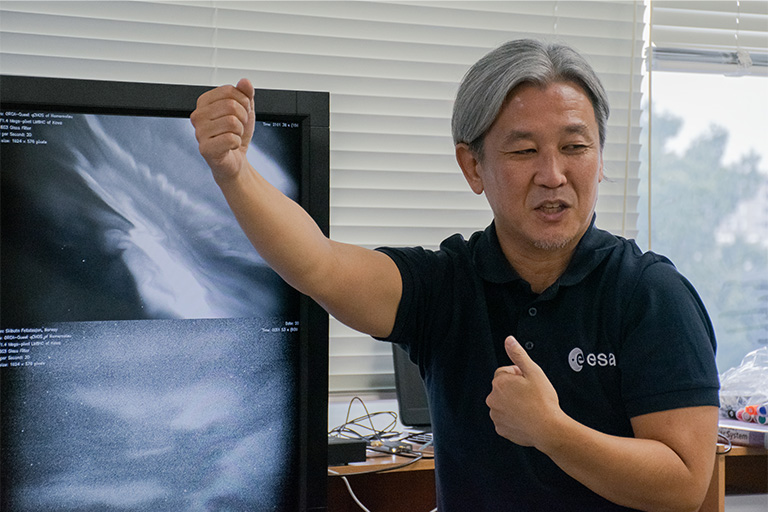
Prospects for research
What are your future research plans?
For future research prospects, I am mainly considering the following:
- Elucidation of the role played by mesoscale auroras with spatial scales below 100 km
- Multidimensional data analysis using ground-based observation data from EISCAT_3D, the Arase satellite, ORCA-Quest, etc.
- Construction of a multipoint optical observation network using multiple ORCA-Quests
Regarding point 1, the mechanisms of mesoscale auroras with fine structures could not be elucidated due to the insufficient spatial resolution of conventional cameras. With the introduction of ORCA-Quest, which has improved spatial resolution, combined with observations from the EISCAT_3D radar currently being developed through international collaboration, we aim to accelerate the elucidation of mesoscale aurora mechanisms.
Regarding point 2, in addition to the aforementioned ORCA-Quest and EISCAT_3D, by combining data from the Arase satellite, we can obtain aurora data from both ground and space perspectives, enabling a multidimensional analysis of aurora mechanisms.
However, to carry out point 2, all of the following conditions must be met:
- The Arase satellite must pass over the observation range of the camera and radar
- Aurora must be present when Arase passes over
- The weather must be clear (not cloudy) when the aurora is present
Since we cannot control the timing of aurora appearances or the weather, we are advancing point 3: the construction of a multipoint optical observation network using multiple ORCA-Quests. This will allow us to cover as wide an area as possible under the orbit of Arase. By placing three cameras at different locations and combining the observed data like a patchwork, we can observe a wide area. We have already purchased the cameras, so we are currently in the process of installing them and waiting for EISCAT_3D to become operational.

EISCAT_3D radar

Arase satellite
Image courtesy of (C)ERG science team
Researcher profile

Prof. Keisuke Hosokawa
Department of Communication Engineering and Informatics, The University of Electro-Communications, Hosokawa Laboratory, Professor
Mar. 2003
Department of Earth and Planetary Sciences, Graduate School of Science, Kyoto University, Ph.D.
Apr. 2004
Assistant researcher, Department of Information and Communication Engineering, The University of Electro-Communications
Apr. 2007
Assistant Professor, Department of Information and Communication Engineering, The University of Electro-Communications
Jun. 2012
Associate Professor, Department of Information and Communication Engineering, The University of Electro-Communications
Apr. 2019
Professor, Department of Computer and Network Engineering, The University of Electro-Communications
Apr. 2024
Director, Center for Space Science and Radio Engineering, The University of Electro-Communications
*The content presented on this page is based on an interview conducted in September 2024.
Related product
The ORCA-Quest 2 is a new qCMOS® camera, the successor to the ORCA-Quest with further advances such as faster readout speeds in extremely low-noise scan mode and increased sensitivity in the ultraviolet region.
Other case studies
- Confirmation
-
It looks like you're in the . If this is not your location, please select the correct region or country below.
You're headed to Hamamatsu Photonics website for JP (English). If you want to view an other country's site, the optimized information will be provided by selecting options below.
In order to use this website comfortably, we use cookies. For cookie details please see our cookie policy.
- Cookie Policy
-
This website or its third-party tools use cookies, which are necessary to its functioning and required to achieve the purposes illustrated in this cookie policy. By closing the cookie warning banner, scrolling the page, clicking a link or continuing to browse otherwise, you agree to the use of cookies.
Hamamatsu uses cookies in order to enhance your experience on our website and ensure that our website functions.
You can visit this page at any time to learn more about cookies, get the most up to date information on how we use cookies and manage your cookie settings. We will not use cookies for any purpose other than the ones stated, but please note that we reserve the right to update our cookies.
1. What are cookies?
For modern websites to work according to visitor’s expectations, they need to collect certain basic information about visitors. To do this, a site will create small text files which are placed on visitor’s devices (computer or mobile) - these files are known as cookies when you access a website. Cookies are used in order to make websites function and work efficiently. Cookies are uniquely assigned to each visitor and can only be read by a web server in the domain that issued the cookie to the visitor. Cookies cannot be used to run programs or deliver viruses to a visitor’s device.
Cookies do various jobs which make the visitor’s experience of the internet much smoother and more interactive. For instance, cookies are used to remember the visitor’s preferences on sites they visit often, to remember language preference and to help navigate between pages more efficiently. Much, though not all, of the data collected is anonymous, though some of it is designed to detect browsing patterns and approximate geographical location to improve the visitor experience.
Certain type of cookies may require the data subject’s consent before storing them on the computer.
2. What are the different types of cookies?
This website uses two types of cookies:
- First party cookies. For our website, the first party cookies are controlled and maintained by Hamamatsu. No other parties have access to these cookies.
- Third party cookies. These cookies are implemented by organizations outside Hamamatsu. We do not have access to the data in these cookies, but we use these cookies to improve the overall website experience.
3. How do we use cookies?
This website uses cookies for following purposes:
- Certain cookies are necessary for our website to function. These are strictly necessary cookies and are required to enable website access, support navigation or provide relevant content. These cookies direct you to the correct region or country, and support security and ecommerce. Strictly necessary cookies also enforce your privacy preferences. Without these strictly necessary cookies, much of our website will not function.
- Analytics cookies are used to track website usage. This data enables us to improve our website usability, performance and website administration. In our analytics cookies, we do not store any personal identifying information.
- Functionality cookies. These are used to recognize you when you return to our website. This enables us to personalize our content for you, greet you by name and remember your preferences (for example, your choice of language or region).
- These cookies record your visit to our website, the pages you have visited and the links you have followed. We will use this information to make our website and the advertising displayed on it more relevant to your interests. We may also share this information with third parties for this purpose.
Cookies help us help you. Through the use of cookies, we learn what is important to our visitors and we develop and enhance website content and functionality to support your experience. Much of our website can be accessed if cookies are disabled, however certain website functions may not work. And, we believe your current and future visits will be enhanced if cookies are enabled.
4. Which cookies do we use?
There are two ways to manage cookie preferences.
- You can set your cookie preferences on your device or in your browser.
- You can set your cookie preferences at the website level.
If you don’t want to receive cookies, you can modify your browser so that it notifies you when cookies are sent to it or you can refuse cookies altogether. You can also delete cookies that have already been set.
If you wish to restrict or block web browser cookies which are set on your device then you can do this through your browser settings; the Help function within your browser should tell you how. Alternatively, you may wish to visit www.aboutcookies.org, which contains comprehensive information on how to do this on a wide variety of desktop browsers.
5. What are Internet tags and how do we use them with cookies?
Occasionally, we may use internet tags (also known as action tags, single-pixel GIFs, clear GIFs, invisible GIFs and 1-by-1 GIFs) at this site and may deploy these tags/cookies through a third-party advertising partner or a web analytical service partner which may be located and store the respective information (including your IP-address) in a foreign country. These tags/cookies are placed on both online advertisements that bring users to this site and on different pages of this site. We use this technology to measure the visitors' responses to our sites and the effectiveness of our advertising campaigns (including how many times a page is opened and which information is consulted) as well as to evaluate your use of this website. The third-party partner or the web analytical service partner may be able to collect data about visitors to our and other sites because of these internet tags/cookies, may compose reports regarding the website’s activity for us and may provide further services which are related to the use of the website and the internet. They may provide such information to other parties if there is a legal requirement that they do so, or if they hire the other parties to process information on their behalf.
If you would like more information about web tags and cookies associated with on-line advertising or to opt-out of third-party collection of this information, please visit the Network Advertising Initiative website http://www.networkadvertising.org.
6. Analytics and Advertisement Cookies
We use third-party cookies (such as Google Analytics) to track visitors on our website, to get reports about how visitors use the website and to inform, optimize and serve ads based on someone's past visits to our website.
You may opt-out of Google Analytics cookies by the websites provided by Google:
https://tools.google.com/dlpage/gaoptout?hl=en
As provided in this Privacy Policy (Article 5), you can learn more about opt-out cookies by the website provided by Network Advertising Initiative:
http://www.networkadvertising.org
We inform you that in such case you will not be able to wholly use all functions of our website.
Close
